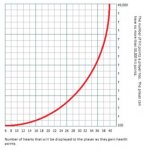unenergizer
New member
- Joined
- Aug 6, 2015
- Messages
- 2
Hi everyone,
I am having a problem coming up with a solution to my problem. I like to do computer programming as a hobby, and am trying to make something, but I am having a hard time getting past this particular math problem. This is a chart that I have:
I need to fill in the chart above with numbers after the equals sign. What I am trying to achieve is what I believe to be a quadratic formula.
The numbers on the left side represent a players hearts in a video game and on the left side, is their actual hit points (health). A player should start with 6 hearts and 100 health. As their health goes up, the player gains more hearts. However, there needs to be a gradual curve making getting hearts in the beginning easy and as time goes by, it gets harder. This would be similar to gaining levels in a RPG game.
I have done several hours of googling. But unfortunately I have come to the conclusion that my math skills are rusty and I need to pick up a math book (and i did purchase one yesterday). I would be very grateful if someone could help me solve this problem and explain how it should be solved.
If any of the information is unclear, please let me know and I will do by best to fill in any gaps.
Thank you for your time!
I am having a problem coming up with a solution to my problem. I like to do computer programming as a hobby, and am trying to make something, but I am having a hard time getting past this particular math problem. This is a chart that I have:
Code:
6 = 100
8 =
10 =
12 =
14 =
16 =
18 =
20 =
22 =
24 =
26 =
28 =
30 =
32 =
34 =
36 =
38 =
40 = 49,000I need to fill in the chart above with numbers after the equals sign. What I am trying to achieve is what I believe to be a quadratic formula.
The numbers on the left side represent a players hearts in a video game and on the left side, is their actual hit points (health). A player should start with 6 hearts and 100 health. As their health goes up, the player gains more hearts. However, there needs to be a gradual curve making getting hearts in the beginning easy and as time goes by, it gets harder. This would be similar to gaining levels in a RPG game.
I have done several hours of googling. But unfortunately I have come to the conclusion that my math skills are rusty and I need to pick up a math book (and i did purchase one yesterday). I would be very grateful if someone could help me solve this problem and explain how it should be solved.
If any of the information is unclear, please let me know and I will do by best to fill in any gaps.
Thank you for your time!

